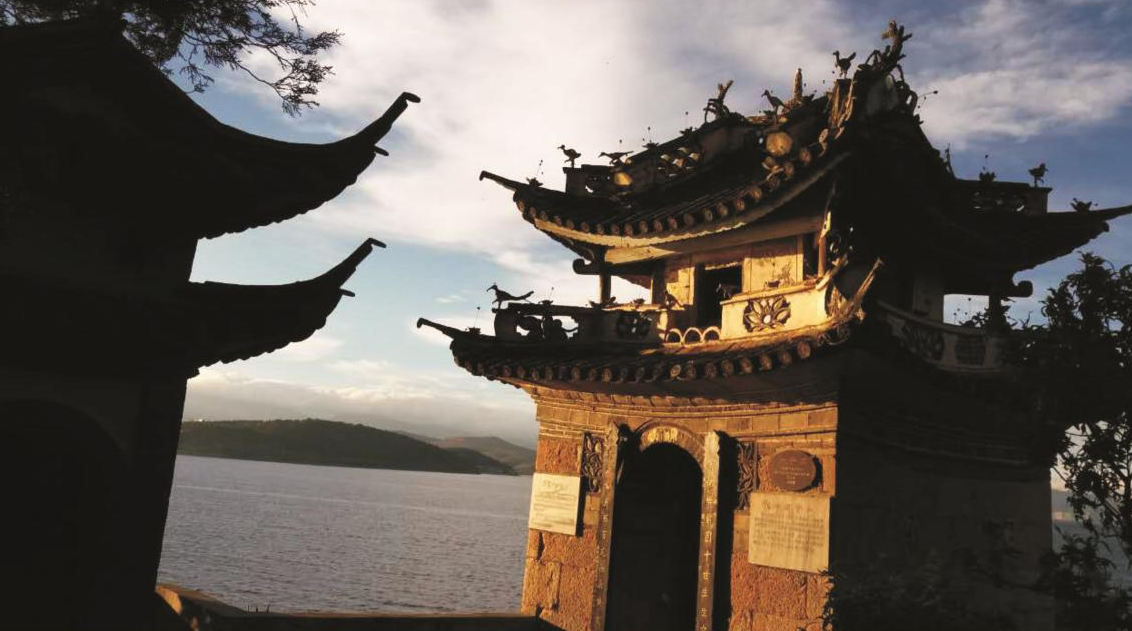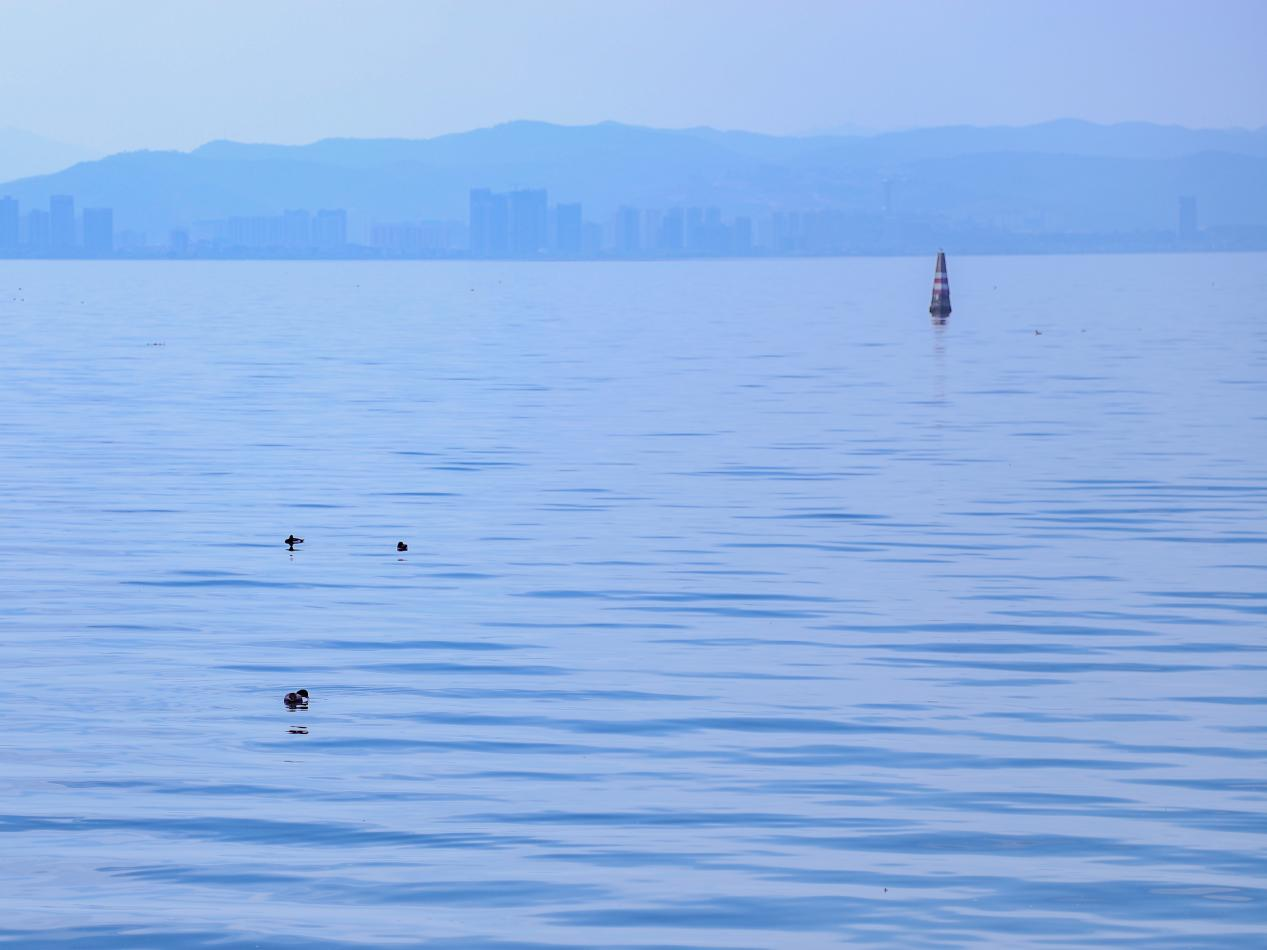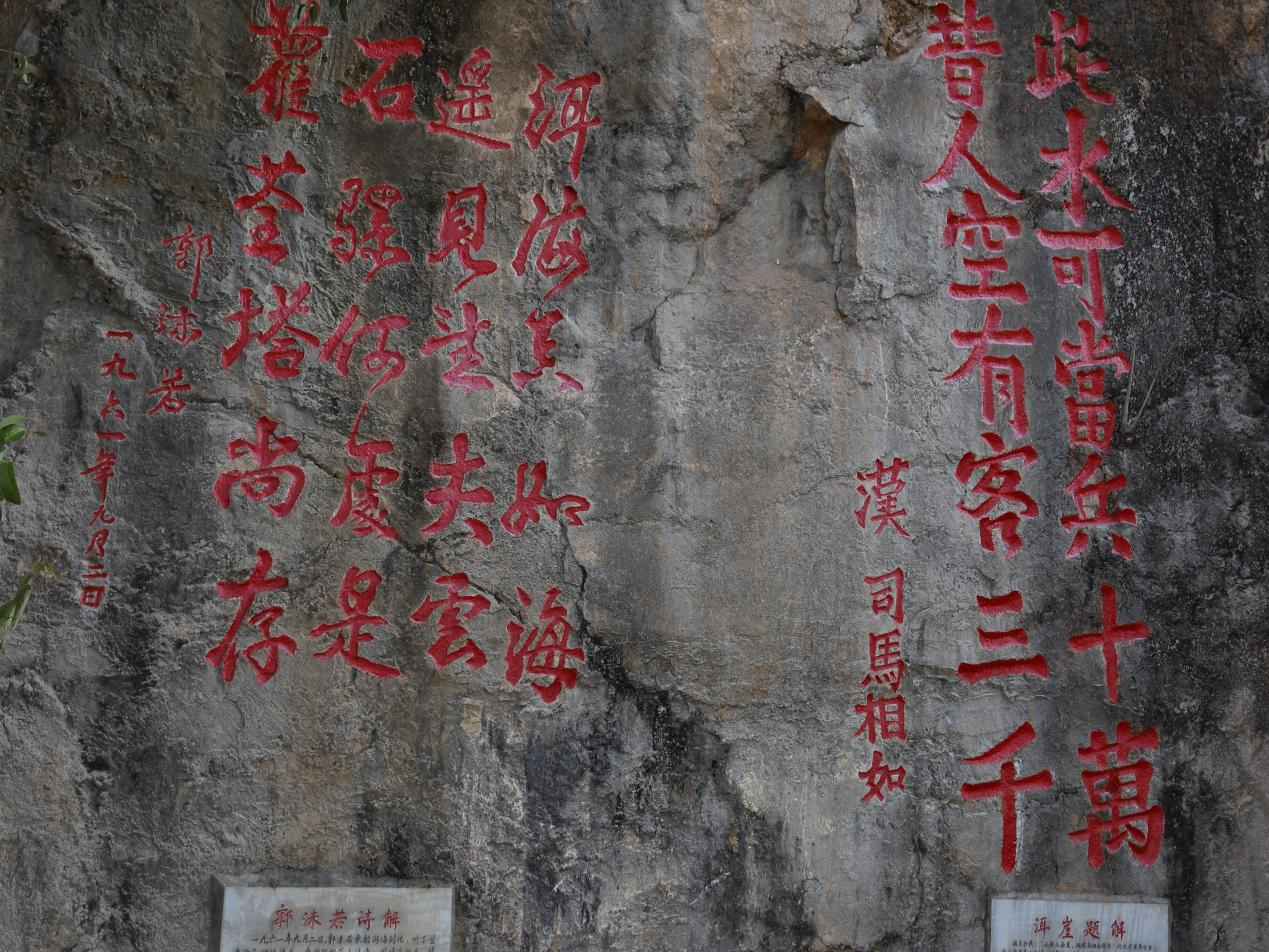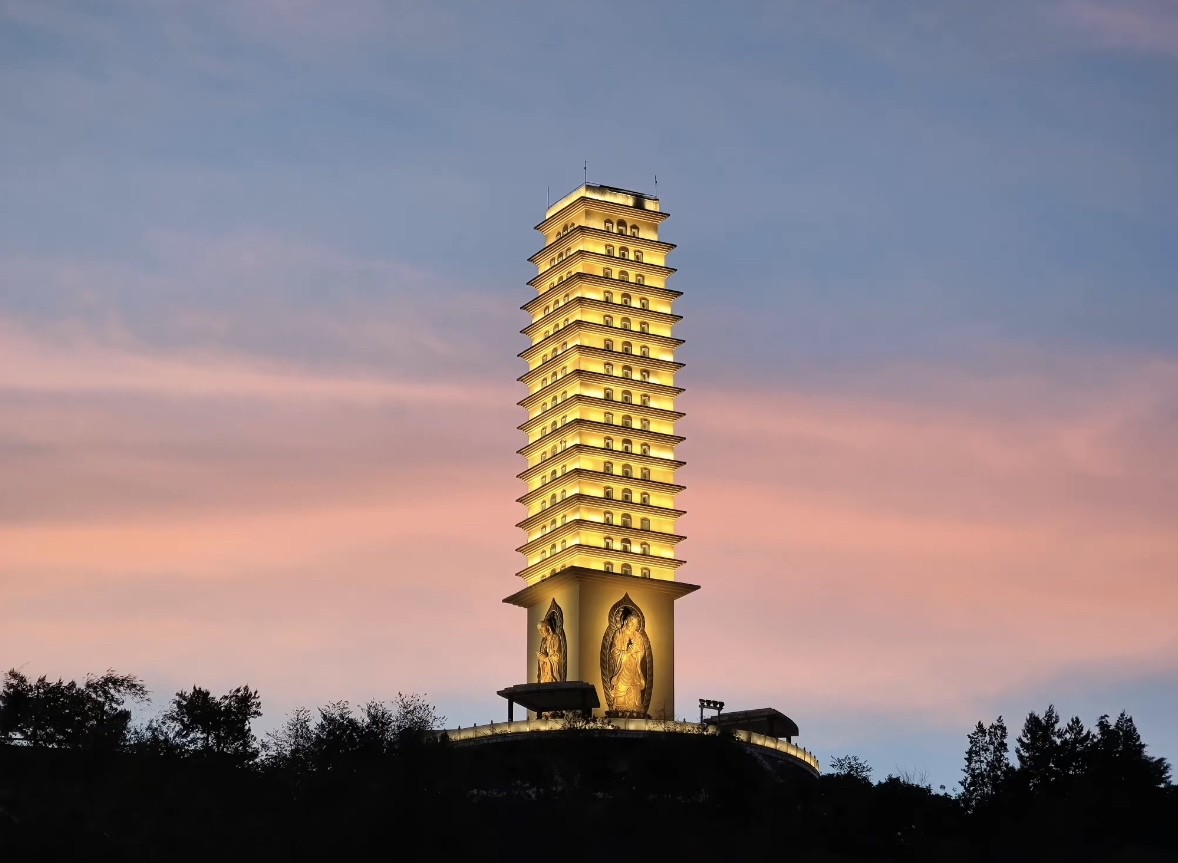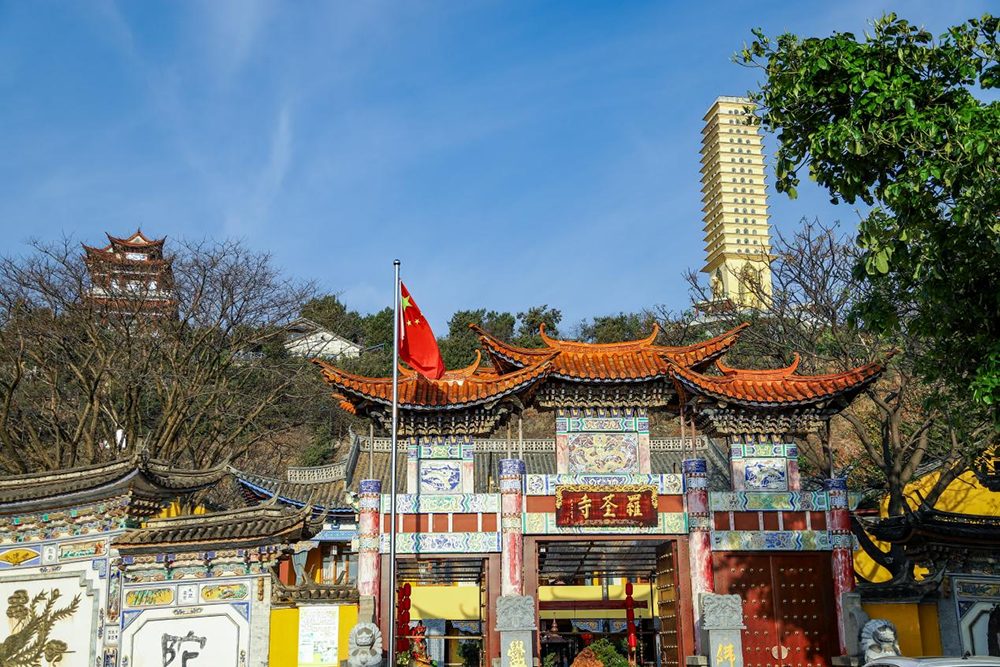The newly built Tianjing Pavilion is located on the ridge of Luoquan Peninsula, while Guanyin Pavilion remains on the coast at the southern end of the peninsula, with the newly built coastal highway running between them. For the safety of tourists and the integration of the scenic area, a sky bridge was built in 2000 across the north-south central axis of Tianjing Pavilion, Guanyin Pavilion, and Shimulozi in the scenic area, crossing the East Coastal Highway at the foot of Yu'an Mountain. The bridge is 12 meters high, with a clearance (distance between the bridge bottom and the ground) of 5.5 meters, and a span of 12.5 meters. It is covered with glazed tile roofs and is made of reinforced concrete, yet possesses a national architectural style. It is particularly magnificent against the backdrop of blue sky, green mountains, and blue water. Especially in the sunlight, it glitters with golden light, appearing majestic and mysterious. From afar, it looks like a rainbow lying across the ridge, hence the name Yu Hong Bridge.
The Prince's Pavilion has two floors, both of which house sculpted images of the Sakyamuni Prince. The pavilion is situated to the south of Erhai Lake and faces north towards the Guanyin Pavilion. The upper floor has an open window at the front to facilitate those praying for a son to "hit the Prince". There is a couplet by the window that reads: "Come, come, come, quickly hit my golden sparrow; Go, go, go, quickly embrace your golden boy." The lower floor is mainly for prayer and incense offerings. There is a couplet by the door that reads: "The ancient Buddha understands the past causes, ten lifetimes of emptiness and form; The small river contains the moon's shadow, a hundred flowers bloom with brilliant articles."
About 165 meters from the shore in front of the present Taizi Pavilion (formerly the site of Tianjing Pavilion) lies a submerged reef, only a small part of which is exposed above the sea surface. This is the legendary Stone Mule. In the Haidong Bai language, it is customarily called "Zhouzhuang" (zoupzuaf), meaning "rock pile". Local gazetteers mostly write it as "Dinghai Zhuang". The Republican-era "Haidong Zhi" includes an entry for "Dinghai Zhuang", stating that "in front of Tianjing Pavilion, Luo Quan stationed the Stone Mule God below it". Legend has it that the hunter Qiaolang, the lover of the Nanzhao princess in the famous mythological story "Waiting for Husband Cloud", was struck down into the sea by Luo Quan's magic here and transformed into a stone mule, pressed down under this rock pile. This reef is called a rock pile because of its shape resembling a stone pillar. The water around the reef is over 20 meters deep. When a strong wind blows, the crevices in the rock emit a sound like the neighing of mules and horses. No wonder people associate it with the Yujufuyu floating clouds—weather clouds—that indicate strong winds, and have created a touching love story. Therefore, Dinghai Zhuang is commonly called Stone Mule in folk tradition, and some also call it the Wife-Waiting Stone.
Many stone carvings originally existed on the coastal cliffs of Luquan Peninsula, but unfortunately, most were destroyed by quarrymen. The only remaining stone carving is a Ming Dynasty inscription on the cliff face near the ancient Luquan ferry. This is less than 100 meters from Guanyin Pavilion at the western end and less than 100 meters from Luquan Temple at the northeast corner. However, there is no access path; to view it, one must look upwards from the beach below the cliff during the dry season. When the tide is high, one can only view it by boat.
Behind Luoquan Temple, about 80 meters north of the newly built Tianjing Pavilion on the mountain ridge, stands an ancient tower without a spire, popularly known as the Topless Pagoda. Paired with the temple, the tower takes its name from the temple and is traditionally called the "Luoquan Pagoda". Like the main tower of the Three Pagodas Temple, known as the "Qianxun Pagoda" (its full name being "Fajie Tongling Mingdaocheng Pagoda"), it is extremely difficult to verify its original name. Guo Moruo, a scholar who was a historian, writer, poet, playwright, calligrapher, and archaeologist, visited Erhai Lake in September 1961 and also referred to the ancient tower as the "Luoquan Pagoda". His poem, "Erhai is truly a sea, the Luoquan Pagoda still exists," is now widely known. Sadly, less than five years after Guo Moruo's visit, the ancient tower was destroyed in July 1966 during the Cultural Revolution. Only a pile of rubble and some of the original Taihe stones used for the tower base—a type of riverbed stone from the eighteen streams of Cangshan Mountain—remain at the site.
The Bai ancient history book "Bai Gu Tong Ji" (also known as "Bai Gu Tong" or "Bo Gu Tong"), completed during the Yuan Dynasty, records that "the evil dragon (original note: also known as Rakshasa) was eliminated by a great bodhisattva, but its kind still lurked in the sea caves of the eastern mountains, causing evil winds and white waves that often capsized boats. A divine monk founded Luoquan Temple on the eastern cliff to subdue it, chanting scriptures within." Ming Dynasty records, such as Xie Zhaoji's "Dian Lue", Li Yuanyang's Wanli "Yunnan Tongzhi", and Qing Dynasty records like Shi Fan's "Dian Xi" and Zhou Yue's Yongzheng "Bin Chuan Zhou Zhi", all contain accounts of Yang Dushi founding Luoquan Temple during the Tang Dynasty. The "Chongxiu Luoquan Si Qingfu Changzhu Bei Ji" (Stele Inscription on the Rebuilding of Luoquan Temple and the Restoration of its Permanent Residents), dated to the 28th year of the Kangxi reign of the Qing Dynasty (1689), states that "on the shore of the East China Sea, there is the ancient Luoquan Temple, founded by the divine monk Daoan during the Tang Dynasty... Tracing back to the Tang Dynasty, it has undergone more than dozens of renovations and modifications." Yuan and Ming dynasty fragments unearthed near the site of Luoquan Temple in 2005 also bear inscriptions such as "the ancient monk Dushi founded the Luoquan Buddhist temple", and "there was a troublesome demonic crocodile that created wind and waves, causing many people to fall ill, and the divine monk Daoan arrived at this mountain... later, Yang Dushi established a Daoist field and made a vow to expand and repair the temple buildings." The above materials indicate that Luoquan Temple was initially built during the Tang Dynasty in the Nanzhao Kingdom. If we take the Jianzhong era of the Tang Dynasty (the era name of Emperor Dezong of Tang, 780-783 AD) as the founding date, it has a history of over 1300 years.



